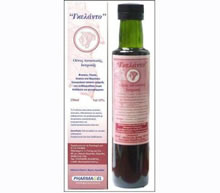
Λεξικό .. Non-allergic asthma
Non-allergic asthma
The traditional view of the pathophysiology of asthma is that its characteristic features are secondary to a major allergic or immunological dysfunction. However, this does not explain intrinsic asthma, which can occur in the absence of atopy. An alternative view is that an abnormality in the airway smooth muscle cell, which is capable of producing inflammatory, immunological and growth factors as well as molecules, which facilitate interaction with inflammatory cells, is the primary or instigating event.
Evidence is rapidly accumulating that the smooth muscle is abnormal, in that it proliferates faster, produces more chemokines and cytokines as well as a different profile of extracellular matrix proteins than its non-asthmatic counterpart. These abnormalities may arise from altered calcium homoeostasis leading to increased mitochondrial biogenesis and/or decreases in the levels of key transcription factors such as CCAAT enhancer binding protein-alpha.
Conditions under which smooth muscle is ablated, such as bronchial thermoplasty, may help us to understand more about the contribution of an airway smooth muscle dysfunction to asthma aetiology[5]. In contrast, patients with a non-allergic asthma have negative skin tests to common allergens and normal total IgE serum levels. They represent about 50% of adult and 20-30% of childhood asthma. Patients with this non-allergic asthma tend to have a more severe disease, but clearly show signs of a similar inflammatory response in the airways as observed in patients with allergic asthmatic [1]. Interestingly, in patients of the non-allergic group, a significant local IgE production in the airways has recently been described [2], indicating that IgE may also play a role in asthma pathogenesis for this subset [3].
The association with increased IgE serum levels is also obvious for other allergic diseases such as seasonal allergic rhinitis (SAR), insect venom allergy or food allergies. The serum levels of IgE antibodies to cow's milk and hen's egg predict the probability of a positive outcome (an allergic reaction) of food challenges in children [4].
1. Oehling AG Jr, Walker C, Virchow JC, Blaser K. Correlation between blood eosinophils, T-helper cell activity markers and pulmonary function in patients with allergic and intrinsic asthma. J Invest Allergol Clin Immunol 1992;2:295-299.
2. Humbert M, Grant JA, Taborda-Barata L et al. High-affinity IgE receptor (FcepsilonRI)-bearing cells in bronchial biopsies from atopic and nonatopic asthma. Am J Respir Crit Care Med 1996;153:1931-1937.
3. Humbert M, Menz G, Ying S et al. The immunopathology of extrinsic (atopic) and intrinsic (non-atopic) asthma: more similarities than differences. Immunol Today 1999;20:528-533.
4. Roehr CC, Reibel S, Ziegert M, Sommerfeld C, Wahn U, Niggemann B. Atopy patch tests, together with determination of specific IgE levels, reduce the need for oral food challenges in children with atopic dermatitis. J Allergy Clin Immunol 2001;107:548-553.
5. Black JL, Roth M. Intrinsic asthma: is it intrinsic to the smooth muscle? Clin Exp Allergy. 2009 Jul;39(7):962-5. Epub 2009 May 4.
Γκέλης Ν.Δ. - Λεξικό Αλλεργίας - Εκδόσεις ΒΕΛΛΕΡOΦΟΝΤΗΣ - Κόρινθος 2013
Gelis Ν.D. - Dictionary of Allergies - VELLEROFONTIS Publications - Corinth 2013




